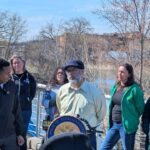Jonas the Peacemaker
Jonas Bronck, who gave his name to the Bronx River, was also a man of peace who sought to reconcile a festering conflict between the Native Americans and the Dutch colonists of New AmsterdamBronck was a deeply religious man who named his new home “Emmaus” for the biblical place visited by the risen Christ, and whose 40-book library contained mainly religious and devotional titles.
While Bronck settled in, steadily souring relations between the Dutch governor William “the Testy” Kieft and the Native Americans came to a head early in 1642 with the murder of Claes Smits by a young Weekguasegeeck. The killing was in retaliation for the earlier murder of a Native American, but that carried no weight with the belligerent Kieft, who launched a search and destroy mission against a Weekguasegeeck village north of Bronck’s Land that only narrowly missed its target.
To stop the spiraling cycle of violence Bronck agreed to host a meeting at Emmaus between the Native Americans and representatives of the Dutch governorThe natives agreed to the Dutch demand that they hand over Smits’ assailant, and a peace was concluded.
But when the Weekguasegeecks were unable to promptly hand over the culprit, William the Testy had a pretext for the war he sought, and he launched devastating raids against native settlements around New AmsterdamIn return he got a general uprising that nearly brought New Amsterdam to its kneesBut Bronck’s peacemaking effort may not have been entirely in vain, for while Siwanoy warriors destroyed European settlements east of Bronck’s River (including that of the recently arrived Anne Hutchinson,) Jonas Bronck’s lands were untouched, and after his death in 1643 his family and tenants were allowed to depart in peace.
– S.P. DeVillo




